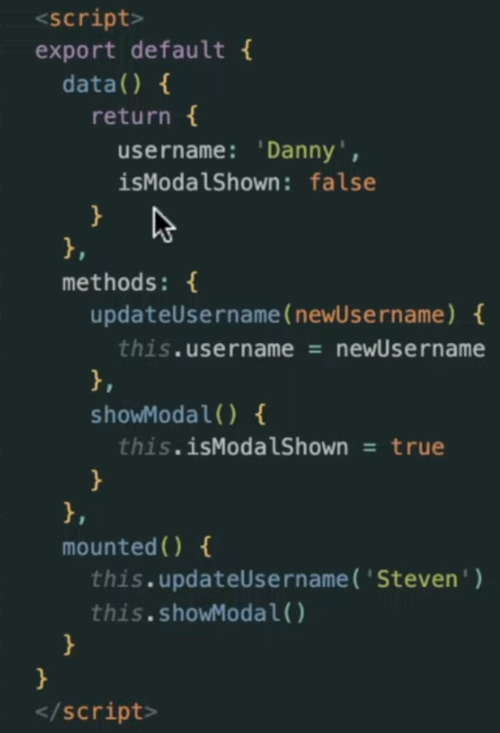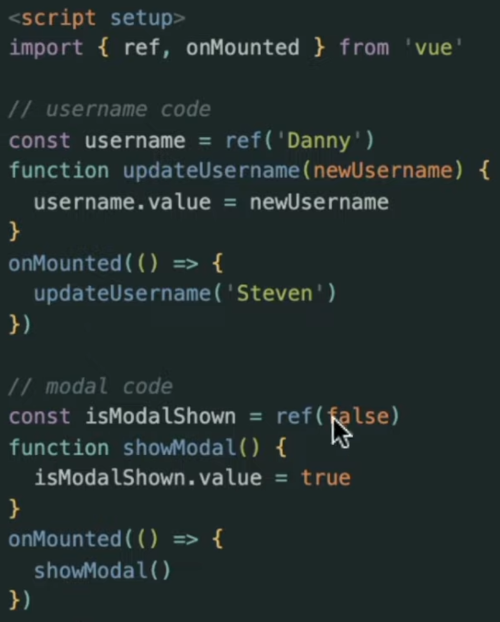Vue Revisited II 2025
Introduction
The changes to Vue are so big I needed to give these changes their own page. First what I will be talking about.
- Composition API
- Data
- Methods
- LifeCycle hooks
- Directives
- Vue Router
- Lists, Teleport, Template Refs, next Tick
- Child Components
- Composables
- State with Pinia
- Bulma
Composition API
So I had forgotten how awful the options API is and since doing my stuff in composition API
Here is the old approach

Here is the new approach

The composables allows better code sharing than the mixins approach. This was done so well I just used it and it worked.
Data
Was much here aside from the reactive method for store non primative refs
<scripts>
const counterData = reactive({
counter:0,
title: 'My Counter'
})
</scripts>
Now you can use v-model to bind to it
<template>
<div>
<h4>Edit Counter Title:</h4>
<input v-model="counterData.title" type="text">
</div>
</template>
Methods
LifeCycle hooks
Directives
So a directive is like v-show, v-if etc. And of course you can make you own.
Old way
<scripts>
{
{
...
directives: {
autofocus: {
mounted(el) {
el.focus()
}
}
}
}
}
</scripts>
<template>
<div>
<input v-model="counterData.title" type="text" v-autofocus>
</div>
</template>
In the new approach you need to create a directive in CamelCase
<scripts>
const vAutofocus = {
mounted(el) {
el.focus()
}
}
</scripts>
It did seem to be a bit silly to even mention this approach but I guess people like continuity. The right apporach is to make a directives directory and export it.
export const vAutofocus = {
mounted(el) {
el.focus()
}
}
</scripts>
Vue Router
Lists, Teleport, Template Refs, next Tick
Not sure why lists were on the list. There is not change really
<template>
<div
v-for="(menuItem, index) in menuItems"
:key="index"
class="pl-4 flex flex-row gap-2 items-center justify-start"
>
<div class="flex font-bold hover:text-headerHover underline">
{{ menuItem.title }}
</div>
</div>
</template>
So for refs this is referring to when you assign a ref to template element.
<template>
<div ref="parentRef" class="w-[35%] flex flex-col text-secondary gap-2">
<div
v-for="(menuItem, index) in menuItems"
:key="index"
:ref="(el) => setMenuItemRef(el as HTMLDivElement, index)"
:class="[
'w-full',
'flex',
'px-8',
'py-4',
index === selectedMenuIndex ? 'bg-[#2F2F2F]' : '',
]"
@click="handleMenuSelected(index)"
>
<Menu :menuItem="menuItem" :isActive="index === selectedMenuIndex" />
</div>
</div>
</template>
And in the script we have
<script setup lang="ts">
import { useScreenSizeDetector } from '@/composables/use-screen-size-detector'
import type { GeneralLinkItem } from '@/types/general-link-item'
import type { ISubMenus } from '@/types/menu-item'
import { ref, computed, watch } from 'vue'
import GeneralSmallMenu from '@/components/GeneralSmallMenu.vue'
import Menu from '@/components/TheMenu.vue'
import SubMenu from '@/components/SubMenu.vue'
defineOptions({
name: 'GeneralMenu',
})
<script setup lang="ts">
const props = defineProps<{
menuItems: ISubMenus[]
generalLinkItems: GeneralLinkItem[]
}>()
// Create refs to hold the DOM elements
const parentRef = ref<HTMLDivElement | null>(null)
const menuItemsRefs = ref<HTMLDivElement[]>([])
const selectedMenuIndex = ref(-1)
const activeMenuY = ref(0)
// Function to set refs for menu items
const setMenuItemRef = (el: HTMLDivElement | null, index: number) => {
if (el) {
menuItemsRefs.value[index] = el
}
}
// Watch for changes to get the active menu ref
watch(selectedMenuIndex, (newIndex) => {
const activeMenuRef = newIndex >= 0 ? menuItemsRefs.value[newIndex] : null
// Your menu position logic here
if (parentRef.value && activeMenuRef) {
const parentRect = parentRef.value.getBoundingClientRect()
const childRect = activeMenuRef.getBoundingClientRect()
const relativeY = childRect.bottom - parentRect.top
activeMenuY.value = relativeY
// Scroll into view if needed
activeMenuRef.scrollIntoView({
behavior: 'smooth',
block: 'nearest',
})
}
})
</template>